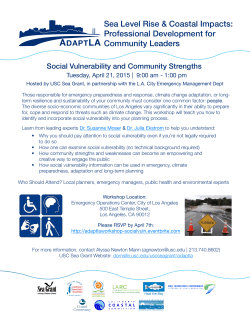
Toby Garfield, NOAA Southwest Fisheries Science Center
Conveying the 2014-2015 warm anomaly environmental and ecological conditions to fishers, regulators, legislative staffers and federal employees Toby Garfield, Chris Harvey and the CCIEA Team SIO Blob meeting, 6 May 2015 A very unusual year Historic “warm blob” Mild El Niño Historic warmth and low snowpack 2013 2014 2015 2 CALIFORNIA CURRENT ECOSYSTEM • • • • • • • Climate Energy Water quality Ship traffic Fisheries Economy Vibrant coastal communities (IEA) Integrated Ecosystem Assessment Ecosystem-Based Management Eastern Pacific sea surface temperatures (SST) were (and are) anomalously warm in 2014-2015 The Gulf of Alaska and the ocean off Baja California were >3°C warmer than average Niño3.4 area Niño3.4: region used to define El Niño state El Niño, ENSO, MEI, Niño3.4, ONI 4 Basin Scale Indicators for the last 3 yrs: PDO: Pacific Decadal Oscillation index indicating long term temperature shifts, NPGO: North Pacific Gyre Oscillation Index indicating strength or volume of gyre flow, MEI: Multivariate El Niño Index indicating interannual variability of temperature The three indices are suggesting that at the end of 2013 there occurred a transition from favorable productivity conditions to generally low productivity conditions! Index Value (Monthly Anomaly) 3 The 2013 Switch 2012 2 2014 1 0 -1 PDO NPGO MEI -2 -3 1/2012 Graph by Andy Leising 1/2013 High Productivity 1/2014 1/2015 Low Productivity + Weak El Niño Sea Surface Temperature anomalies (SSTa) for April 2013, 2014, 2015 2013 2013: record upwelling 2014 2014: alongshore gradient 2015 2015:??? It wasn’t just the ocean that was warm. 2014 In California, 2014 weather was not only dry, but it was also extraordinarily hot • Surface air temperature record was almost off the charts, ~ 1 °C warmer than the previous record • Extraordinary warmth was confined to the southwest, centered in California 7 Almost every day in the last year was warmer than average at most West Coast locations http://www.cpc.ncep.noaa.gov/products/global_monitoring/temperature/global_temp_accum.shtml 8 http://www.nytimes.com/interactive/2015/03/05/us/one-giantpicture-of-all-the-snow-across-the-us.html?smid=tw-share&_r=0 2013 40% 2014 25% 2015 5% CALIFORNIA CURRENT FOOD WEB DEPENDS ON UPWELLING The source waters and upwelling strength determine the primary productivity 10 Regional Indicator: Cumulative Upwelling 2014/15 SST anomaly April 21, 2015 Newport Line NH20 Trinidad Line TH02 Monterey Bay It’s early to describe this spring’s upwelling, but the winter ocean was much warmer. CalCOFI 90 90 How do these anomalies affect us? (case study: salmon) Environmental Drivers 13 How do these anomalies affect us? (case study: the outlook for salmon 2-3 year out it grim) Environmental Drivers Ecological Interactions Human Activities 14 Coastwide U.S. commercial fishery landings • Total landings just updated; 1981 to 2014 15 Other human activities • Sectors related to fisheries: – West Coast shellfish aquaculture (through 2012) – West Coast finfish aquaculture (through 2014) – U.S. total seafood demand (through 2013) • Per capita U.S. seafood demand remains flat • IEA is monitoring other human activities as well – – – – Shipping Energy extraction Coastal development Pollution 16 VULNERABILITY OF PEOPLE TO CLIMATE CHANGE Vulnerability of vessels that target forage fish to climate change Is a vulnerable fish a vulnerable fishery? Sensitivity (mean proportion of revenue) Premise: increased vulnerability of marine resources to expected climatic change, and reduced resilience in human communities increased vulnerability 0.6 ● Market squid ● Pacific herring Adapative capacity (vessel diversification) 0.27 0.26 0.25 0.24 0.23 0.22 0.21 0.4 ● Pacific hake 0.2 ● Pacific sardine ● Northern anchovy ● Surf smelt ● Whitebait smelt ● Pacific mackerel ● Jack mackerel 0.0 0.8 1.0 1.2 Exposure (vulnerability of forage fish) Samhouri et al. in review 1.4 http://coastwatch.pfel.noaa.gov
© Copyright 2025










